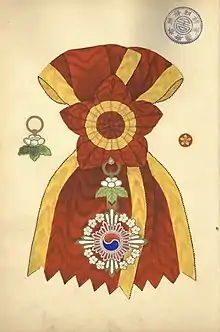Order of the Plum Blossom
The Order of the Plum Blossom (also called as Order of the Ehwa) was the Order of chivalry of the Korean Empire. It was the third highest order of Korean Empire.
| Order of the Plum Blossom 대훈위 이화대수장 | |
|---|---|
 | |
| Type | Dynastic order |
| Awarded for | Merit |
| Presented by | the Korean Empire |
| Eligibility | Civilians and military, Korean and foreign, who got the first class of order of the Taegeuk and has special merit after receiving order of the Taegeuk |
| Status | Obsolete |
| Established | April 17, 1900 (in Korea) |
| Precedence | |
| Next (higher) | Order of the Auspicious Stars |
| Next (lower) | Order of the Taegeuk |
History
Order of the Plum Blossom was the part of the establishment of orders in 1900 by Gojong of Korea. Gojong said that the order of the Plum Blossom was given to those who already got the first class of Order of the Taegeuk and has special merit after receiving Order of the Taeguk. Only the Emperor can decide the recipient of Order of the Plum Blossom.[1] It was named after flower Ehwa which was the national flower of the Korean Empire. There were 62 recipients of Order of the Plum Blossom.
Form
Order of the Plum Blossom was divided into Grand Cordon and Medal. Perimeter of Grand Cordon was 7.5 centimeters and the medal was 7 centimeters. Two were just the same but size was only difference. They were made of silver and gold. On the obverse of medal, '훈공정장' was engraved.[2]
Grand Cordon was worn from the right shoulder to the left flank, it is crossed at the end, folded with a cloth, and a suit is attached, and the head is hung on the left chest.[1]
Notable recipients
- Shim Soon-taek on 16 March 1902[3]
- Inoue Kaoru on 24 March 1902[4]
- Yi Jae-wan on 16 September 1904[5]
- Min Young-hwan on 16 September 1904[5]
- Komura Jutarō on 19 September 1904[6]
- Yikuang on 27 February 1905[7]
- Kuwashi Okazawa on 7 March 1905[8]
- Yi Jae-gak on 19 March 1905[9]
- Ōura Kanetake on 28 May 1905[10]
- Kuroki Tamemoto on 28 December 1906[11]
- Terauchi Masatake on 28 December 1906[11]
References
- "조선왕조실록". sillok.history.go.kr. Retrieved 2022-01-06.
- 이강칠 (1999). 대한제국시대훈장제도 (in Korean). 白山出版社. pp. 94–95. ISBN 978-89-7739-259-5.
- "조선왕조실록". sillok.history.go.kr. Retrieved 2022-04-14.
- "한국고전종합DB". db.itkc.or.kr. Retrieved 2022-04-16.
- "조선왕조실록". sillok.history.go.kr. Retrieved 2022-04-14.
- "한국고전종합DB". db.itkc.or.kr. Retrieved 2022-04-16.
- "한국고전종합DB". db.itkc.or.kr. Retrieved 2022-04-14.
- "한국고전종합DB". db.itkc.or.kr. Retrieved 2022-04-16.
- "한국고전종합DB". db.itkc.or.kr. Retrieved 2022-04-14.
- "한국고전종합DB". db.itkc.or.kr. Retrieved 2022-04-14.
- "한국고전종합DB". db.itkc.or.kr. Retrieved 2022-04-14.